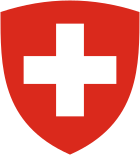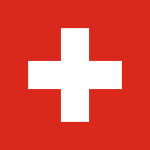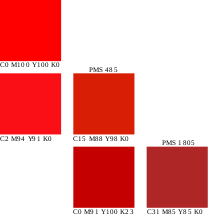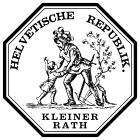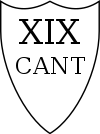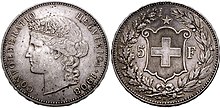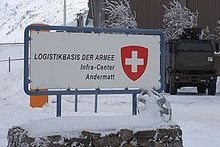
Unterwalden, translated from the Latin inter silvas(between the forests), is the old name of a forest-canton of the Old Swiss Confederacy in central Switzerland, south of Lake Lucerne, consisting of two valleys or Talschaften, now two separate Swiss cantons, Obwalden and Nidwalden.

The 26 cantons of Switzerland are the member states of the Swiss Confederation. The nucleus of the Swiss Confederacy in the form of the first three confederate allies used to be referred to as the Waldstätte. Two important periods in the development of the Old Swiss Confederacy are summarized by the terms Acht Orte and Dreizehn Orte.

The canton of Uri is one of the 26 cantons of Switzerland and a founding member of the Swiss Confederation. It is located in Central Switzerland. The canton's territory covers the valley of the Reuss between the St. Gotthard Pass and Lake Lucerne.

The national flag of Switzerland displays a white cross in the centre of a square red field. The white cross is known as the Swiss cross or the federal cross. Its arms are equilateral, and their ratio of length to width is 7:6. The size of the cross in relation to the field was set in 2017 as 5:8. Alongside the flag of Vatican City, the Swiss flag is one of only two square national flags in the world.
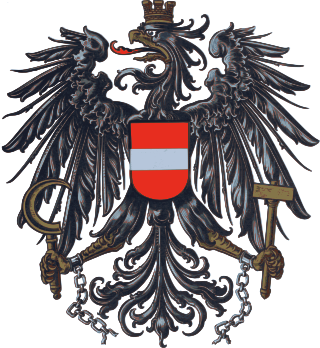
The current coat of arms of the Republic of Austria has been in use in its first forms by the First Republic of Austria since 1919. Between 1934 and the German annexation in 1938, the Federal State used a different coat of arms, which consisted of a double-headed eagle.

The coat of arms of Germany displays a black eagle with a red beak, a red tongue and red feet on a golden field, which is blazoned: Or, an eagle displayed sable beaked langued and membered gules. This is the Bundesadler, formerly known as Reichsadler. It is one of the oldest coats of arms in the world, and today the oldest national symbol used in Europe.
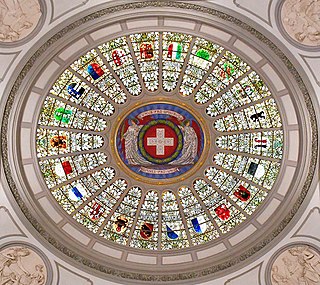
Each of the 26 modern cantons of Switzerland has an official flag and a coat of arms. The history of development of these designs spans the 13th to the 20th centuries.

Eidgenossenschaft is a German word specific to the political history of Switzerland. It means "oath commonwealth" or "oath alliance" in reference to the "eternal pacts" formed between the Eight Cantons of the Old Swiss Confederacy of the late medieval period, most notably in Swiss historiography being the Rütlischwur between the three founding cantons Uri, Schwyz and Unterwalden, traditionally dated to 1307. In modern usage, it is the German term used as equivalent with "Confederation" in the official name of Switzerland, Schweizerische Eidgenossenschaft, rendered Confédération and Confederazione in French and Italian, respectively. The related adjective, eidgenössisch, officially translated as Swiss federal, is used in the name of organisations, for example the Eidgenössische Technische Hochschule, Swiss Federal Institute of Technology. The term Eidgenosse refers to the individual members of the Eidgenossenschaft. It is attested as early as 1315, in the Pact of Brunnen, referring to the cantons of Uri, Schwyz and Unterwalden. The abstract noun Eidgenossenschaft is attested in the 15th century. In modern usage, Eidgenosse is sometimes used for "Swiss citizen", especially for those citizens of purely Swiss origin, not immigrated.
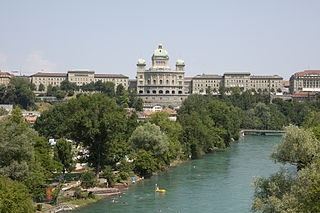
The Federal Palace is a building in Bern housing the Swiss Federal Assembly (legislature) and the Federal Council (executive). It is the seat of the government of Switzerland and parliament of the country. The building is a listed symmetrical complex just over 300 metres (980 ft) long. It is considered one of the most important historic buildings in the country and listed in the Swiss Inventory of Cultural Assets of National Importance. It consists of three interconnected buildings in the southwest of Bern's old city. The two chambers of the Federal Assembly, the National Council and Council of States, meet in the parliament building on Bundesplatz.

The periods of Restoration and Regeneration in Swiss history lasted from 1814 to 1847. "Restoration" is the period of 1814 to 1830, the restoration of the Ancien Régime (federalism), reverting the changes imposed by Napoleon Bonaparte on the centralist Helvetic Republic from 1798 and the partial reversion to the old system with the Act of Mediation of 1803. "Regeneration" is the period of 1830 to 1848, when in the wake of the July Revolution the "restored" Ancien Régime was countered by the liberal movement. In the Protestant cantons, the rural population enforced liberal cantonal constitutions, partly in armed marches on the cities. This resulted in a conservative backlash in the Catholic cantons in the 1830s, raising the conflict to the point of civil war by 1847.

The coat of arms of Bern, along with the associated flag and heraldic colours, are used both by the Swiss city of Bern and by the canton of the same name. They were also used by the former district of Bern until its abolition in 2009.

The Old Swiss Confederacy, also known as Switzerland, or the Swiss Confederacy was a loose confederation of independent small states, initially within the Holy Roman Empire. It is the precursor of the modern state of Switzerland.

The coat of arms of Berlin is used by the German city state as well as the city itself. Introduced in 1954 for West Berlin, it shows a black bear on a white shield. On top of the shield is a special crown, created by the amalgamation of the mural crown of a city with the so-called people's crown, used in Germany to denote a republic. Berlin's various boroughs use their own emblems.

Over its long history, the Holy Roman Empire used many different heraldic forms, representing its numerous internal divisions.

The English name of Switzerland is a compound containing Switzer, an obsolete term for the Swiss, which was in use during the 16th to 19th centuries. The English adjective Swiss is a loan from French Suisse, also in use since the 16th century.

A shooting thaler is a silver coin in thaler size minted to commemorate a Schützenfest or free shooting in Switzerland.
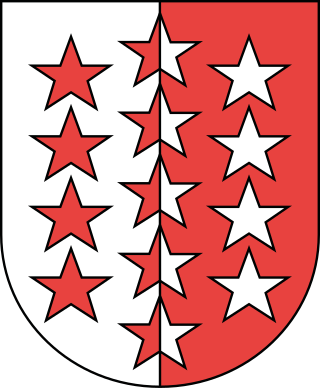
The coat of arms of the Swiss canton of Valais is in red and white, divided vertically with thirteen five-pointed stars in opposite colours. The stars represent the thirteen districts. It was introduced in 1815, when the Valais was detached from the French Department of Simplon to join the join the Swiss Confederacy.

A number of cross symbols were developed for the purpose of the emerging system of heraldry, which appeared in Western Europe in about 1200. This tradition is partly in the use of the Christian cross an emblem from the 11th century, and increasingly during the age of the Crusades. Many cross variants were developed in the classical tradition of heraldry during the late medieval and early modern periods. Heraldic crosses are inherited in modern iconographic traditions and are used in numerous national flags.

Eidgenössische Schützenfeste are the Swiss federal shooting competitions organized by the Schweizerischer Schützenverein since 1824.
